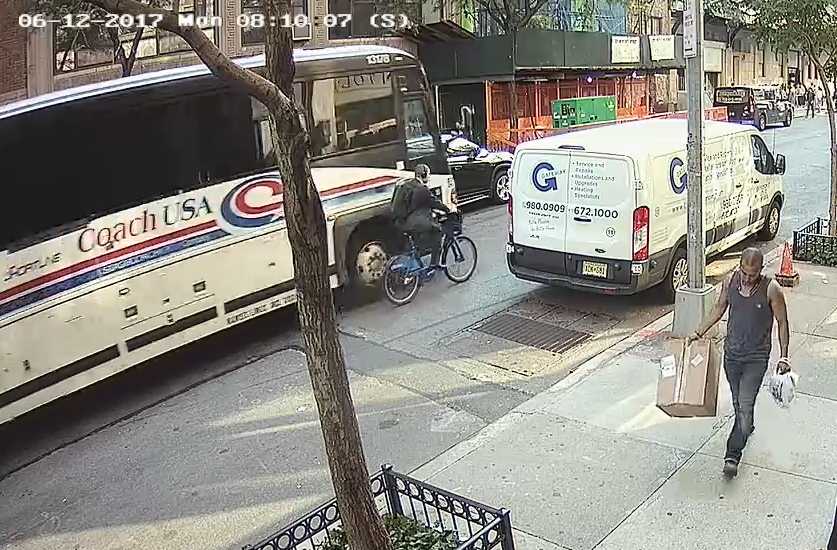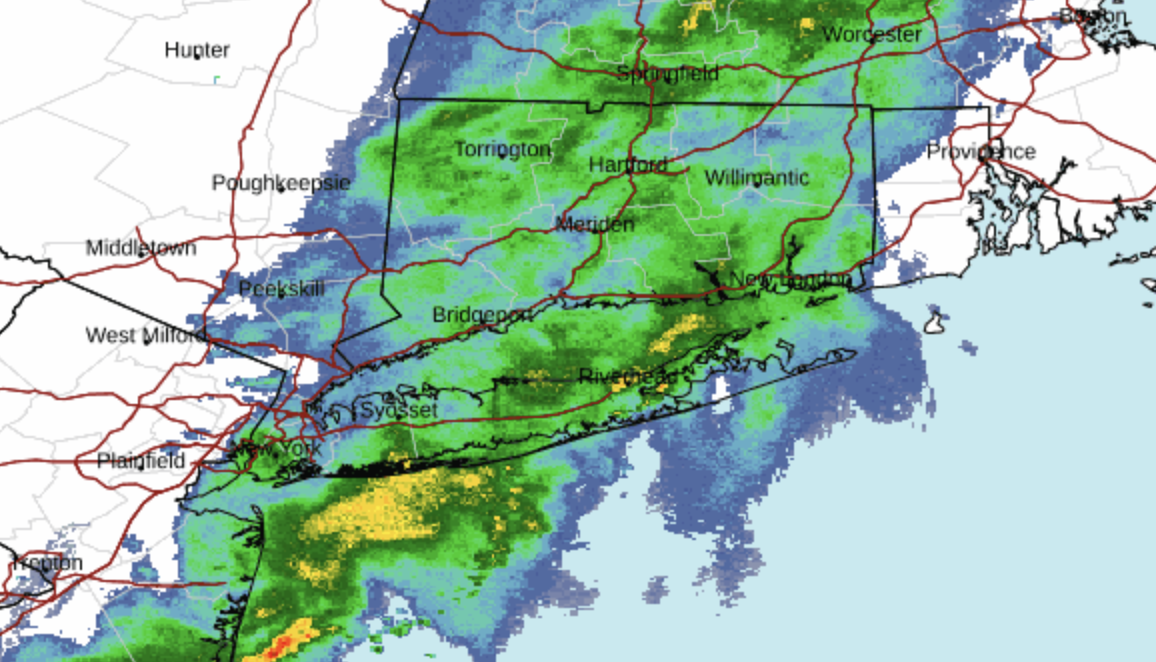This is what criminally negligent homicide looks like.
Watch the video below of bus driver Dave Lewis killing cyclist Dan Hanegby, which was released Thursday as part of Lewis's trial. You see Hanegby cycling. And you see Lewis drive his Coach USA behemoth right into him. Lewis didn't hit the brake. Lewis hit the gas. He should be sent away for years.
But Lewis is on trial for merely violating Hanegby's "right of way," a misdemeanor punishable by just 30 days in jail.
This is akin to letting Jack the Ripper off with a misdemeanor for soliciting a prostitute.
The facts are indisputable and the video is incontrovertible, which is why every New Yorker who cycles or walks needs to run to the window and scream, "I'm mad as hell and I'm not going to take it anymore": Hanegby was cycling on narrow W. 26th Street when he encountered a pinch point due to an illegally parked car on his left and another vehicle, a van that was also possibly illegally parked, on his right. Hanegby rode in the center of the roadway, which is legal under state vehicular law, and advisable given that either vehicle could have easily doored the cyclist.
Lewis approached Hanegby from behind and never slowed down as he approached the same pinch point. As he tried to pass Hanegby at high speed, he clipped the cyclist's handlebars, sending him to the pavement, where he was fatally struck by the bus's back wheels.
Lewis's defense — that he honked his horn at Hanegby — is exactly why he should have been charged with criminally negligent homicide and not merely violating Hanegby's right of way.
Legal experts agree that the standard for such a charge is simple: state penal Law section 15.05(4) defines "criminal negligence" as failing to perceive a substantial risk that one's actions or inaction would result in another person's death. The risk must constitute a "gross deviation" from the standard of care that a reasonably prudent person would observe under the same circumstances. It's a Class E felony, punishable by four years in prison.

Obviously, a "reasonably prudent person" would see that there was no way to squeeze his eight-and-a-half-foot-wide bus into a lane of traffic barely 12-feet wide that was already occupied by a two-and-a-half-foot-wide cyclist. A reasonably prudent person would have hit the brake rather than take the risk.
More important: we're talking about a reasonably prudent person today, not ten or more years ago before the massive increase in cycling and when Vision Zero became official policy," added lawyer Steve Vaccaro.
"A reasonably prudent person in New York City is different in 2017 than in 2007," he said. "We have had a dramatic expansion of people biking on the street, we've had Vision Zero campaigns. We've had Citi Bike. Today's reasonably prudent New Yorker is far more aware of the risks. That affects how we measure a professional driver's acts. And that should be taken into account."
Vaccaro and others have focused on Lewis's defense — "Hey, I honked!" — as another reason why the driver could have been charged with criminally negligent homicide or at least reckless endangerment in the second degree, a misdemeanor punishable by up to a year in jail.
"Reckless endangerment requires an awareness of the risk — and the honking demonstrated that the driver was aware of the risk," Vaccaro said. "It is absolutely shocking to me that this bus driver did this. He apparently has the mentality that if someone is in front of him, all he needs to do is honk and if the person doesn't get out of his way, whatever happens to that person is their, not his, responsibility. Many drivers feel that way. But that is not the law.”
Vance's decision to not seek higher charges against Lewis is gutless — but he's just the latest law enforcement official who believes in the notion that it's just a "tragic accident" when a driver kills a cyclist or a pedestrian with his car.
But the law is clear: There is no such thing as an accident when — honk, honk! — the driver is aware of the risk.
And Vance knows that. In 2011, he pursued manslaughter charges against an Upper West Side driver who slammed into a pedestrian as she rushed to beat a red light — always a risky move. The driver, Jessica Altruz, faced 10 years in prison, but Vance allowed her to plead it down to a three-year sentence.
Vance, of course, has been inconsistent on street safety, declining to charge the taxi driver whose right-of-way violations led to the death of cyclist Madison Lyden on Central Park West last month. And he's not alone. Queens District Attorney Richard Brown just allowed a driver to plead guilty to reckless endangerment for killing 17-year-old Madeline Sershen in a Whitestone crosswalk earlier this year — but let the driver off with no jail time at all.
Vaccaro smells two rats: the DAs themselves, but also a quirk in the way the right-of-way law is executed.
Shortly after the law was enacted in 2014, the city reached a settlement with the Transport Workers Union, which represents some bus drivers, that watered-down the right-of-way law by forcing prosecutors and police to demonstrate that a driver both failed to yield and failed to exercise due care, a higher burden of proof. (One irony, of course, is that if the right-of-way law hadn't passed, Lewis might not have been charged at all, said Marco Conner, legal expert for Transportation Alternatives.)
"The settlement muddied the waters," Vaccaro said. "Dan definitely had the right of way. He was in front. But if the driver can show he used 'due care,' he has a defense to the right-of-way violation. And this driver said he honked. If there were drivers on a jury, many would, indeed, say, 'He honked! He used due care! He alerted the bicyclist!' So that puts a greater burden on the prosecutor to explain that, no, the bicyclist had the right of way, the bus driver shouldn't have been there. And honking does not mean 'due care.' There are too many people who believe that honking at a cyclist is what a driver is supposed to do."
And it leads to victim-blaming. But anyone asking that question — "Why didn't Hanegby get out of the way?" — is asking the wrong question.
The right question is, "Why didn't the bus driver just slow down?"
The answer is, "Because he acted with criminal negligence."
Which raises another question: "Why didn't Cy Vance charge him with that?"
Vance's office said it could not comment while the trial is ongoing.
Gersh Kuntzman is Editor-in-Chief of Streetsblog. When he gets really angry, he writes the Cycle of Rage column. They’re archived here.






